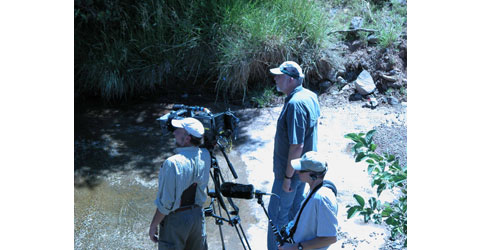
| Product
List and Order Desk |
|
| Contact Us | |
| Home |

|
|

PRODUCER'S NOTES
By Paul Bockhorst I am gratified to have played a part in bringing the story of Fossil Creek to the public. The significance of this story extends far beyond a single stream and watershed in Arizona’s Rim Country. What is happening at Fossil Creek is emblematic of a large-scale shift in human consciousness. It is another sign that we are entering a new era in human history, one in which we undertake the restoration of ecosystems damaged by earlier forms of human use. This new epoch will be characterized by an effort to balance fulfillment of hu-man needs with protection of the natural systems that support human life. It is a vast enterprise destined to extend over many generations. Large scale restoration projects require special human assets: knowledge and commitment, creativity and cooperation, flexibility and perseverance, to name a few. Significantly, all of these qualities have been pre-sent during the fifteen-year effort to return the Fossil Creek watershed to a natural state. And that elevates Fossil Creek from a story of regional interest to a case study of national and even international importance. Vital lessons are being learned at Fossil Creek, and they can be applied to environmental restoration efforts elsewhere. “A River Reborn” highlights a number of these lessons: Sound Science: For environmental restoration projects to be effective, they must be grounded in sound science. Edward Fox, the Vice President for Environmental Affairs at Arizona Public Service, makes this point in the documentary: “You have to do the best science you can in order to inform yourself to make sound decisions,” Fox says. “Making decisions in a vacuum is idiocy.” At Fossil Creek, scientists from Northern Arizona University have conducted—and continue to conduct—wide-ranging research. This re-search provides a critical database for decision-making by resource managers, as well as for assessing the results of the restoration effort. Inclusion & Dialogue: Over time, all of the major stakeholders at Fossil Creek managed to enter into a dia-logue. Participants included Arizona Public Service, the operator of the hydroelectric facilities; the Yava-pai-Apache Nation, whose member tribes have long inhabited the Fossil Creek watershed; seven environ-mental NGOs; and several federal and state resource management agencies. Despite significant differences in outlook and objectives, all the parties remained in dialogue and endeavored to find win-win solutions. It’s especially noteworthy that the final settlement was reached without litigation. Cooperation among Environmental Advocacy Groups: Several environmental advocacy organizations took part in the discussions, including American Rivers, the Center for Biological Diversity, The Nature Conservancy of Arizona, the Arizona Riparian Council, Northern Arizona Audubon, The Sierra Club, and Friends of Arizona Rivers. They overcame initial differences and succeeded in creating a functional coali-tion. Complementary expertise further strengthened their position. For example, some organizations were able to contribute scientific knowledge, while others provided technical expertise regarding federal envi-ronmental and regulatory law. Cooperation among Resource Management Agencies: The theme of cooperation extended into the res-toration phase. A remarkable level of cooperation was achieved among a number of federal and state re-source management agencies charged with protecting native fish populations at Fossil Creek. In the docu-mentary, Kirk Young of the Arizona Game and Fish Department paints a remarkable picture: “We’ve never had this kind of cooperation, with so many agencies and so many people. It was, ‘Who can do what? Who has the wherewithal to do this aspect of it?’ And the focus was, ‘Get this project done and get it done right, because we can’t make mistakes on this. There’s too much at stake.’” Almost every participant in the native fish restoration project was deeply affected by the interagency cooperation, and many resource mangers said that it was most rewarding experience of their career. Long-term Perspective: Environmental restoration projects generally take many years. For that reason, it’s essential to develop a long-term perspective and to cultivate staying power. Andy Laurenzi, a biologist who has been involved at Fossil Creek for fifteen years, emphasizes the importance of perseverance. “Ninety percent of success is just showing up,” he says in the documentary, “and I think the one lesson that we have to learn over and over again is just persistence. It’s just not giving up.” Monitoring & Adaptive Management: The vast majority of environmental restoration projects have no follow-up monitoring or assessment. Thus there’s no way to know how successful they really are. At Fossil Creek, monitoring is an integral part of the process, as is a management strategy known as “adaptive man-agement.” In the documentary, Jack Stanford, an authority on the effects of dams on rivers, explains the strategy: “We have to approach these large, complex problems like river restorations from an adaptive point of view. That means that we use our best science to put a management action in play, but we must evaluate it. If we don’t evaluate it, we won’t know whether we achieved our goals or not. Moreover, we won’t know how to modify our actions so that the payoff is bigger.” Wise Stewardship: Restoration is more of a long-term process than a one-time event. Because the restora-tion effort at Fossil Creek could be undermined by thoughtless public behavior, it’s essential to foster con-tinuing support and good stewardship practices among user groups. Stream ecologist Jane Marks sees both an opportunity and a challenge associated with increased recreational activities at Fossil Creek: “Fossil Creek provides a real opportunity to involve the public in helping share stewardship with the Forest Ser-vice. But it’s a challenge, how to make sure we don’t love this ecosystem to death.” The story of Fossil Creek continues to unfold, and the outcome of the restoration project is far from certain. The process is complex and protracted, with continuing threats to the health of the ecosystem. Neverthe-less, I am heartened by what has been accomplished to date, and I hope that viewers will be, too. I hope they will see Fossil Creek as a point of light in the often gloomy discussion of environmental issues. To me, this story provides a welcome reminder that hope is a more powerful force than fear and pessimism. It also encourages me to believe that through commitment, cooperation, and the wise application of knowledge we can promote an era of environmental healing. 11/28/06 Home /
Art and Architecture / Nature and the Environment / History and Culture / |
